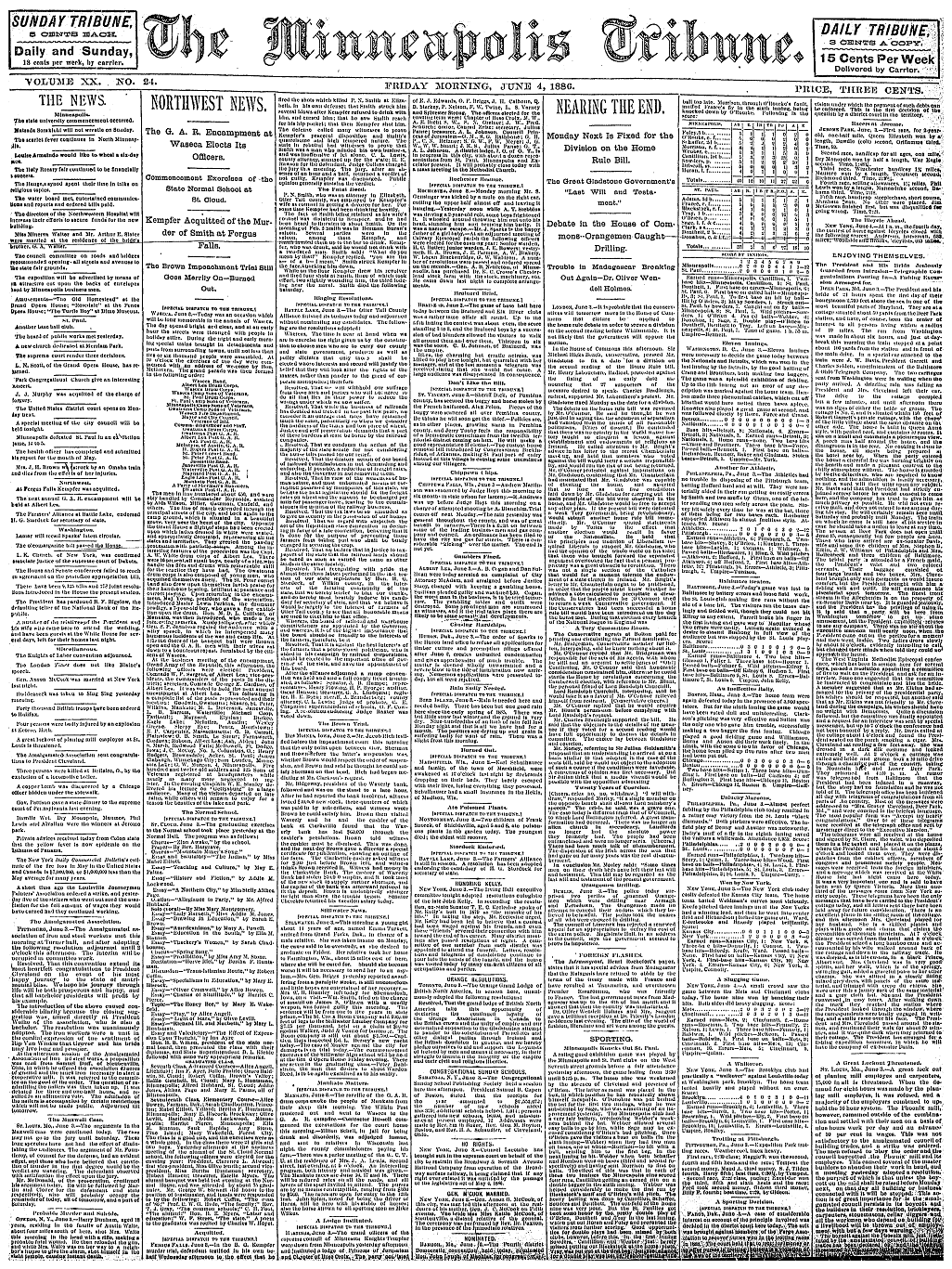Minneapolis Tribune
Minneapolis daily tribune
The Minneapolis Tribune, currently published as Star Tribune, is one of the oldest operating publications in the state of Minnesota, having been founded in 1867, the same year Minneapolis was incorporated as a city. In that year local Republican businessmen Colonel William S. King and Dorlius Morrison discontinued their Republican-leaning Minneapolis newspapers--the State Atlas and the Minneapolis Daily Chronicle--to create one politically Republican daily newspaper to unify the local Republican party.
King and Morrison founded the Tribune Printing Company, which published the first issue of the newspaper, then called the Minneapolis Daily Tribune, on Saturday, May 25, 1867. It was a morning newspaper with four pages and nine columns of content that served the communities of Minneapolis and St. Anthony; local, state, national, and international news and legal notices made up the bulk of the newspaper’s content. John T. Gilman served briefly as the first editor, followed later in 1867 by Major George K. Shaw. Shaw promoted the development of the city of Minneapolis and the state of Minnesota through his editorials; in the January 7, 1868 issue Shaw argued “we are possessed of resources capable of unlimited development. The possibilities are infinite--the probabilities sufficiently gratifying to the most ardent believer in Minneapolis’ future greatness.”
The merger of St. Anthony with Minneapolis, which increased the population of Minneapolis to 25,000, was reported in the February 14, 1872, issue. Around this same time, disputes with the St. Paul Pioneer-Press began over the Tribune’s reporting of the growth of Minneapolis. The Pioneer-Press called Tribune editor Jim Greene the “most successful impromptu liar in Minnesota.” With new leadership, the Tribune Co. took over publication of the Minneapolis Tribune in January 1876. Looking to end the misrepresentations of both cities’ newspapers, the Tribune Co. announced the merger of the Tribune with the Pioneer-Press to form the Pioneer-Press and Tribune in April of 1876. Commonly referred to as the Dual City Pioneer-Press and Tribune, this newspaper likely folded on October 28, 1876.
In response to the outrage expressed by Minneapolis citizens over this merger, the Minneapolis Tribune resumed in print on May 1, 1876 as a four-page evening edition. In the inaugural issue, the Tribune assured readers “the interests of the Tribune are identical with those of the city. Both will pull together, fight together and win together.” Another new publishing company, the Minneapolis Tribune Co., took over the paper in June 1877. The number of pages increased to eight to twelve pages around this time. State and regional news, court news, and news on the railroad industry made up the bulk of the newspaper’s content. The Washburn A Mill explosion in Minneapolis is discussed in the May 3, 1878 issue.
On November 19, 1882 the Tribune was renamed the Daily Minnesota Tribune in order to differentiate this paper from newspapers with the title Tribune published in other states. The Minnesota Tribune Co. was established two days later and became the proprietor. State political news, Stillwater news, and sports news made up the bulk of the newspaper’s content. Heeding to the demand of St. Paul citizens, there was also news relating to the interests of St. Paul. The newspaper published a scathing article in the October 27, 1883 issue entitled “Wanted - A Government that can Protect,” attacking the US Supreme Court’s ruling that found certain parts of the Enforcement Act of 1875 unconstitutional, because the ruling allowed room for discrimination on the basis of race.
The newspaper returned to the title Minneapolis Daily Tribune on March 22, 1884. New machinery and processes allowed for additional content, including expanded regional news and news from the University of Minnesota. Sunday issues were twenty-four pages long and the remaining issues twelve pages long. A detailed description of the layout of the present day location of the Minnesota State Fairgrounds at its opening year is reported in the September 8, 1885 issue.
William J. Murphy became editor and publisher in March 1891, elevating the quality of the newspaper. With a new typesetting machine and a price drop of most editions, the issues increased in size to ten to twenty-four pages long for weekdays and Saturdays and thirty-four to fifty-six pages long for Sunday issues. In February 1907 Murphy launched a 5 o’clock edition, titled the Minneapolis Evening Tribune. The morning and evening newspaper circulation combined in 1907 was 101,165 compared to 55,102 in 1900.
In December 1909 Murphy renamed the main edition of his newspaper the Minneapolis Morning Tribune. Murphy’s brother assumed the role of editor and publisher following Murphy’s death in October of 1918. At the time of his passing, Murphy was in the process of building the Manistique Pulp & Paper Company in Manistique, Michigan, to make print paper stock for the newspaper. The July 11, 1920 issue was the first printed on this paper stock.
In February 1930 both the morning and evening editions of the newspaper were renamed Minneapolis Tribune, and the evening edition was dropped in August of that year. The newspaper returned to the title Minneapolis Morning Tribune in 1939, and then again to Minneapolis Tribune in 1964. In April 1982 the Minneapolis Tribune merged with the Minneapolis Star, forming the Minneapolis Star and Tribune. The newspaper has published daily as Star Tribune since 1999.
The microfilming of some of the newspapers was made possible by ProQuest LLC.
